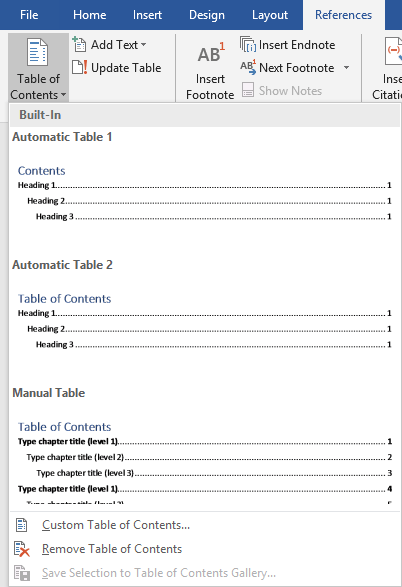
- #WORD 2016 TABLE OF CONTENTS PAGE NUMBERING HOW TO#
- #WORD 2016 TABLE OF CONTENTS PAGE NUMBERING UPDATE#
If you divide the document into parts, you can add page numbers to just one specific part of the document. Setting page numbers on a part of a document In other cases, the top alternative, updating the page numbers only, is likely sufficient. If you have added any new headings in the document or changed them, select the bottom option shown in the image below.
#WORD 2016 TABLE OF CONTENTS PAGE NUMBERING UPDATE#
In Word, you can perform the update by right-clicking the table of contents and selecting the command Update Field in the pop-up menu. When you add or remove text in the document, you also have to update the table of contents. The table of contents is normally not updated automatically. Otherwise the table of contents cannot be updated. Please note that the table of contents must be created in the document where the actual text is. The program will create a table of contents at the location you specified. Accept each change by clicking OK, and approve the settings by clicking OK. In the dialog box, you can make changes concerning fonts and other settings for the table of contents. Then click Modify to open the Style dialog box. If you want to customise the appearance of the table of contents yourself, select From template. At the bottom of the window, you can specify the settings for page numbers, the number of heading levels included in the table of contents, and the leader character to be used.

The Preview window displays the different options. Now you can customise the appearance of your table of contents to suit your wishes. This will open a dialog box (see image below). A menu will open displaying the list of automatic table of contents styles available in the program, allowing you to select one to use in the new table of contents.Īlternatively, you can customise the table of contents of your document as you wish by clicking Custom Table of Contents. Then select the Table of contents icon in the Table of contents group under the References tab. You can create a new blank page in the document by placing the pointer at the beginning of the document and selecting Blank page on the Insert tab.

Usually it is created on a blank page at the beginning of the document. Move the cursor to the location where you want to place the table. To create a table of contents, your document must use heading styles. If you change the appearance of the table of contents by editing it, any changes you make will disappear when you update the table of contents! To achieve permanent changes, edit the style used by the table of contents.

Styles for tables of contents are normally named from TOC 1 to TOC 9: the name of the style comes from the words Table of Contents, and the numbers refer to the heading levels. You can also change the appearance of the table of contents by editing the style of the table of contents. Word processors offer different predefined formats for tables of content. The table of contents will show the document’s headings in the page order. When you create a table of contents, the program will find the headings formatted using the styles and use them to generate the table of contents. Setting up a table of contents is easy if you have used the heading styles (Heading 1, Heading 2, etc.) to format the headers in your document.
#WORD 2016 TABLE OF CONTENTS PAGE NUMBERING HOW TO#



 0 kommentar(er)
0 kommentar(er)
